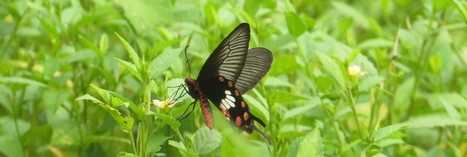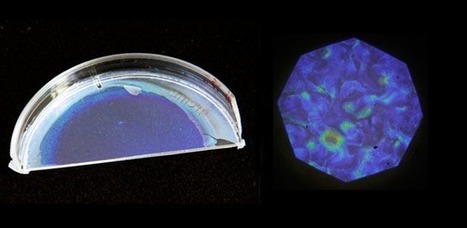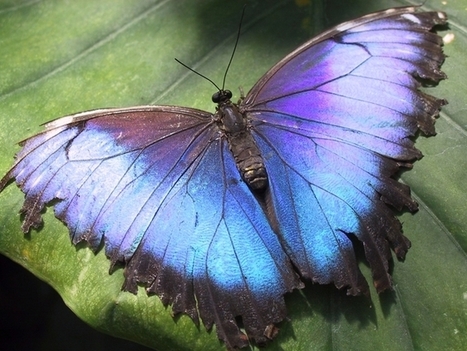 Your new post is loading...
 Your new post is loading...
Researchers recently took cues from butterflies to design thin film solar cells that can better absorb light. The rose butterfly, common to India, has soft black wings that keep the insect warm with the sun’s heat. Mimicking the design of the butterfly’s wings, the scientists created a solar cell that The Verge reports can gather light twice as efficiently.
Photo details: A Karner Blue on hawkweed, Joel Trick, U.S. Fish and Wildlife Service. Wikimedia Commons, public domain.
"The effect is known from the smart phone: Sun is reflected by the display and hardly anything can be seen. In contrast to this, the glasswing butterfly hardly reflects any light in spite of its transparent wings. As a result, it is difficult for predatory birds to track the butterfly during the flight. Researchers of KIT under the direction of Hendrik Hölscher found that irregular nanostructures on the surface of the butterfly wing cause the low reflection. In theoretical experiments, they succeeded in reproducing the effect that opens up fascinating application options, e.g. for displays of mobile phones or laptops."
"The rare blue morpho butterfly is among the largest butterflies in the world and one of the most spectacular with its brown wings that suddenly turn iridescent blue. This amazing display happens when blue light reflects off the layers of microscopic scales on its wings. 3M scientists studied the butterfly to mimic this effect in a window film."
Brightly-coloured, iridescent films, made from the same wood pulp that is used to make paper, could potentially substitute traditional toxic pigments in the textile and security industries. The films use the same principle as can be seen in some of the most vivid colours in nature, resulting in colours which do not fade, even after a century. Some of the brightest and most colourful materials in nature – such as peacock feathers, butterfly wings and opals – get their colour not from pigments, but from their internal structure alone.
"Imitating nature is not a new idea. When the GE team put Morpho wings under a powerful microscope, they saw a layer of tiny scales just tens of micrometers across. In turn, each of the scales had arrays of ridges a few hundred nanometers wide. This complex structure absorbs and bends light and givesMorfo butterflies their trademark shimmering blue and green coat."
"The Mirasol display technology (developed by Qualcomm) is based on biomimetics - that is, technology that imitates nature. The natural phenomenon that makes a butterfly’s wings or a peacock’s feathers shimmer and give off their rich, striking colors is the same exact quality that drives how Mirasol displays generate color. How do butterflies and peacocks do it? Through microscopic structures on their wings and feathers they are each able to create truly vivid colors simply by causing light to interfere with itself. This "interference" is the reason the term "interferometric" comes into play."
"The Morpho is a jewel among butterflies, with its gracefully contoured, iridescent blue wings flashing in the breeze. Familiar from the cover of Illustra's film Metamorphosis, this species exhibits additional intelligent designs the film didn't have time to discuss. Their brilliant color comes not from pigments but from precisely aligned structures in the wing scales that play tricks with light, producing what physicists call "structural color." Certain colors are canceled out, and others reinforced, by the arrangement of "photonic crystals" that resemble tiny trees made of biomolecule chitin. Engineers have already mimicked the iridescence by creating photonic crystals of their own. But there's more. The structures on Morpho butterfly wings also absorb heat, repel water, and control the flow of vapors. The Morpho is a treasure house of design ideas for biomimetics projects, as research news from the University of Exeter reveals. From fabrics to cosmetics to sensors, all kinds of innovations are being inspired by this one genus of butterfly."
By mimicking microscopic structures in the wings of a butterfly, an international research team has developed a device smaller than the width of a human hair that could make optical communication faster and more secure.
In the quest to draw power from the sun, nothing is more motivated than plants and insects.
Morphotex is the world’s first optical coloring fiber, inspired by the chromogenic principle of Morpho butterflies that inhabit areas along the Amazon in South Africa. Called “living jewels,” the cobalt-blue wings of Morpho butterflies impart vivid color although they have no pigmentation.
"When last we heard from GE and its Morpho-butterfly inspired sensors, all the talk was about detecting chemicals. [...] In the latest issue of Nature Photonics, however, the company's researchers show that the wing-like structures are just as good at detecting heat as they are ricin attacks."
|
From the wonderful world of biomimicry comes a solar energy breakthrough based on the posture at rest of a small butterfly called the Cabbage White. Who knew that voguing is still a thing? Apparently, this stylin’ butterfly forms a uniquely angled “V” with its wings, which according to new research from the UK’s University of Exeter indicates a new pathway for developing lighter, more efficient solar energy harvesting systems.
"The Cabbage White butterfly may irritate gardeners with its unrelenting taste for brassicas but it may hold the key to making solar panels more efficient. A team of experts from the University of Exeter have shown that mimicking the v-shaped posture adopted by Cabbage Whites to heat up their flight muscles before take-off, can raise the amount of solar power by nearly 50 per cent. The secret appears to be the angle that the butterflies hold their wings, approximately 17 degrees from horizontal. It could even improve the effectiveness of sunbathing."
"The German automation giant unleashes a swarm of new robotic insects. [...] The theme of Festo’s “Bionic Learning Network” program this year is “Join the Network,” and their flagship projects are both based around swarms of small robots that mimic the way insects work together and interact with each other."
Industry and consumer awareness of biomimetics is on the rise as demand for naturals continues to climb, with the combination of science and nature increasingly appealing for skin care products.
"We studied a novel photoanode structure inspired by butterfly wing scales with potential application on dye-sensitized solar cell in this paper. Quasi-honeycomb like structure (QHS), shallow concavities structure (SCS), and cross-ribbing structure (CRS) were synthesized onto a fluorine-doped tin-oxide-coated glass substrate using butterfly wings as biotemplates separately."
"The TED2014 conference kicks off today in Vancouver, marking the 30th anniversary of the event. The theme of this year's conference is "the next chapter," and each attendee will receive a sample of what could be the next chapter in anti-counterfeit technology. The TED2014 ID badges feature a small iridescent panel with a "30 years TED" logo. The image isn't a hologram, but is created by billions of nano-scale holes. The technology is inspired by the wings of the Morpho butterfly, and this is one of its first major real-world applications. The super-tiny holes reflect and transmit light in a distinctive way, making the logo easy to identify and hard to copy."
"Butterfly wings can do remarkable things with light, and humans are still trying to learn from them. Physicists have now uncovered how subtle differences in the tiny crystals of butterfly wings create stunningly varied patterns of color even among closely related species. The discovery, reported today in the Optical Society's (OSA) open-access journal Optical Materials Express, could lead to new coatings for manufactured materials that could change color by design, if researchers can figure out how to replicate the wings' light-manipulating properties."
Butterfly wings have inspired the design of a tiny crystal that could make telecommunications faster.
"A Canadian company is fighting counterfeiters by employing one of the most sophisticated structures in nature: a butterfly wing. To be precise, Nanotech Security Corp. in Vancouver is using the natural structure of the wings of a Morpho butterfly, a South American insect famous for its bright, iridescent blue or green wings, to create a visual image that would be practically impossible to counterfeit. The technology was developed at British Columbia’s Simon Fraser University, and licensed to the company."
Now no one can say butterflies are all style and no substance. This might look like a pretty lily pad but it is actually a wafer created with lasers to mimic the iridescent colours of a butterfly's wings. For extra credit, Shu Yang at the University of Pennsylvania in Philadelphia, who led the project, also made the wafer water-repellent - another property of butterflies' wings, which helps them fly through rain.
Radiant light film contains no metal whatsoever, so it’s non-corroding, thermally stable, non-conductive, and won’t produce electro-magnetic interference; it’s a well-mannered material that manages to create a striking effect with a minimum of fuss. Taking a cue from butterfly wings, the colors in the film are created NOT through the use of pigments but rather through a series of microscopic ridges spaced a few hundred nanometers apart. Variations in the spacing of the ridges produce a range of colors (blue to magenta to gold) though the reflection and interference of different wavelengths of light, and as a result the material appears to change hue as you adjust your viewing angle.
|
 Your new post is loading...
Your new post is loading...
 Your new post is loading...
Your new post is loading...

































